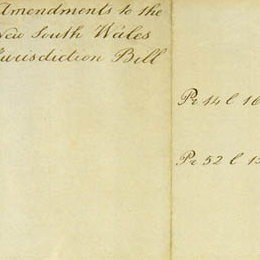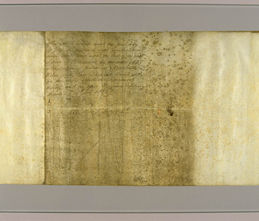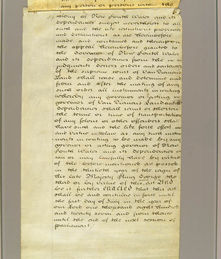

New South Wales Act 1823 (UK)
Significance
This document repealed the New South Wales Courts Act 1787 and authorised the establishment of a Legislative Council and Supreme Court in New South Wales, and a Supreme Court in Van Diemen's Land. The new law also provided that, by an Order-in-Council, Van Diemen's Land could become a separate Colony.The detailed provisions of this Act provided for the establishment of a Supreme Court of Van Diemen's Land which would hear all pleas, civil, criminal or mixed. It would have the same powers as the common law courts of King's Bench, Common Pleas and Exchequer in England, and also the Equity Court of Chancery there. The new Supreme Court also was given ecclesiastical jurisdiction, so it could decide such matters as probate and letters of administration.
Civil cases were normally to be heard before the Chief Justice and two magistrates, but if all parties agreed, the magistrates could be replaced by a jury of 12 men. Appeals from civil cases decided in the Supreme Court could go to a Court of Appeal comprising the Governor and Chief Justice. An appeal to the Privy Council was possible when more than £500 was involved. In criminal cases, a jury of seven military or naval officers would be assembled. Most of these procedures resembled those of the Courts of Criminal and Civil Judicature abolished by this Act.
In addition, Section 8 of the Act authorised the King, if so advised by the Privy Council, to introduce trial by jury, and Section 19 authorised the creation of Courts of Quarter Sessions to try crimes not punishable by death. Section 24 authorised the creation of a Legislative Council of New South Wales by Royal Warrant with appointed, rather than elected, members.
Section 44 of this Act authorised the separation of Van Diemen's Land from New South Wales which took place under the 1825 Order-in-Council.
History
This Act was a result of the recommendations of Commissioner John Thomas Bigge, sent from London in 1819 to investigate the state of the Colonies of New South Wales and Van Diemen's Land. His report was critical of the administration of both places, and prompted reorganisation, including the administration of justice.In 1823 New South Wales was still a penal colony, considered by the British Government not yet ready for a representative government. However, the Legislative Council provided for in this Act can now be seen as a first step towards a 'responsible' Parliament.
Although its members were all appointed by Britain's Secretary of State, they had the power to advise the New South Wales Governor in the exercise of his legislative powers. Councillors' opposition could, in normal circumstances, defeat a law proposed by the Governor. In addition, the Council had control over local appropriation of revenue.
Decisions of Governor and Council remained subject to veto by the Crown. Proposed laws had first to be certified by the Chief Justice of the Supreme Court as compatible with English law, and each proposed law was required to be set before the British Parliament.
There was a 'sunset clause' to this provisional Act, which was to terminate in five years (Section 45). The succeeding legislation was the Australian Courts Act 1828.
Sources
Castles, Alex, An Australian Legal History, Law Book Company, Sydney, 1982.
Giblin, WR, The Early History of Tasmania, 1804–1828, vol. 2, Melbourne University Press, Melbourne, 1939.
Melbourne, ACV, Early Constitutional Development in Australia, University of Queensland Press, Brisbane, 1963.
Shaw, AGL (ed.) and John West, The History of Tasmania, Angus & Robertson, Sydney, 1971.
Description
Handwritten on membranes of vellum, sewn end-to-end and then rolled. The vellum is in creamy shades and the ink is brown. 
Detail of the amendments to the New South Wales Act 1823 (UK).
| Long Title: | An Act to provide, until the First Day of July One thousand eight hundred and twenty-seven, and until the End of the next Session of Parliament, for the better Administration of Justice in New South Wales and Van Diemen's Land, and for the more effectual Government thereof and for other Purposes relating thereto. |
| No. of pages: | 59 + 1 insertion + title |
| Medium: | Vellum |
| Measurements: | Each membrane: 18–19 inches x 12 inches |
| Provenance: | British Parliament |
| Features: | Discolouration of the title page as this part of the vellum formed the outside of the rolled document |
| Location & Copyright: | House of Lords Record Office |
| Reference: | 4 Geo. IV C.96 |



